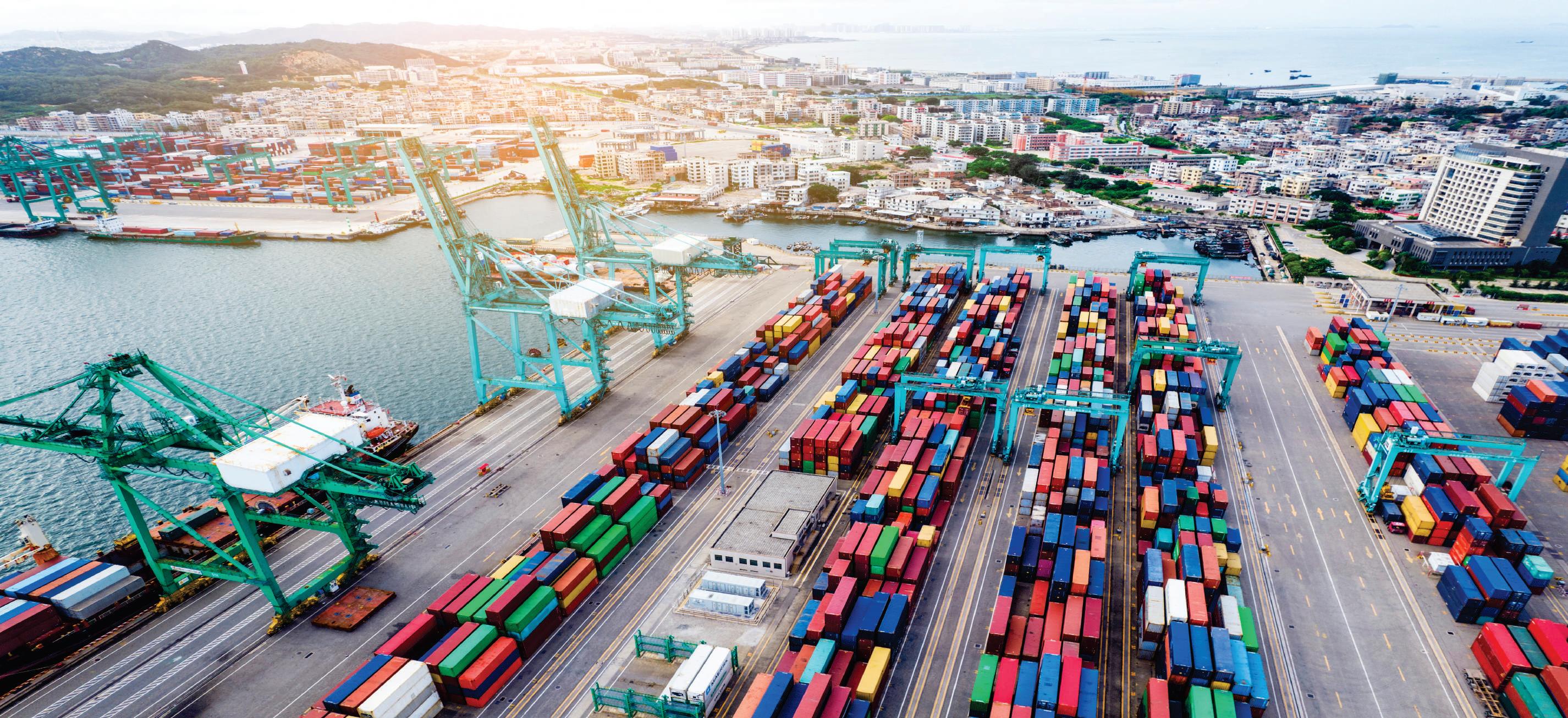
9 minute read
DEEPAK MAHURKAR & NIKHIL KALANE
[ 118 ] | COLUMN
THE WINDS OF CHANGE: GREEN HYDROGEN IN THE CHEMICAL INDUSTRY
Advertisement
DEEPAK MAHURKAR
PARTNER PWC INDIA


NIKHIL KALANE
PRINCIPAL CONSULTANT PWC INDIA
The previous few decades have witnessed an ever-increasing drive towards promoting sustainable energy sources to protect the environment, ensure supply security and promote energy independence. Corporates, nations, and international agencies across the world are driving initiatives committed to Paris Agreement on Climate Change and COP 26 eliminating net greenhouse gas (GHG) emissions by mid-century. While India aims to become a net zero nation by 2070, EU and China aim to reach net zero by 2050 and 2060 respectively. To achieve the Paris Agreement’s goal of limiting global warming to 1.5 °C, eight times increase in global decarbonization rate is required.1
This trend is affecting the chemical industry due to its energy intensive nature and dependence on hydrocarbons as major feedstock contributing to the GHG emissions. At the same time, customers and end-consumers are demanding suppliers to ensure that their products and services do not add to the problem. IEA points out that the technologies for achieving 75% of the required emissions cuts by 2050 are not commercially available today.2
This challenge calls for new strategies & instruments and a need for a root-and-branch transformation. At the same time, it also opens a set of opportunities for the chemical sector to position itself as a key partner in the sustainability-driven transformations of its customers’ industries. Chemical companies that prepare early to comply with rigorous environmental, social, and governance (ESG) standards will have an advantage in the long term. This can only be achieved by unleashing far-reaching innovation within the chemical industry and its value chain, and by implementing ESG-driven innovation strategies. One such strategy is to utilize Hydrogen for
COLUMN | [ 119 ]
energy decarbonization and as green feedstock for chemical industry.
HYDROGEN AS AN ENABLER TO DECARBONIZATION
Although efficiency increase & electrification are most effective ways to reduce GHG emissions, certain applications have no real alternative to H2. For example, coking coal free steel production via Direct Reduced Iron (DRI) route, chemical industry (feedstock), transport (long haul aviation, maritime shipping), long term storage for seasonal power generation, etc. As a result, the blue and green variants of hydrogen are gaining prominence and are being considered as the ultimate solution for deep decarbonization in various hard-to-abate and hard-to-electrify sectors.
Hydrogen is primarily produced via steam methane reforming of natural gas or naphtha. This hydrogen is termed as Grey. The same Grey hydrogen is termed Blue if CO2 emitted in the process is captured. On the other hand, Green hydrogen is produced by splitting the water molecule via electrolysis using energy generated from renewable sources such as solar energy, wind energy etc. resulting in zero CO2 emissions. The advances in electrolysis technology and the falling cost of renewable energy have paved the way for mass production of green hydrogen.
HYDROGEN AS A CRUCIAL FEEDSTOCK FOR THE CHEMICAL INDUSTRY
Hydrogen is an important feedstock for the chemical industry having application in manufacturing of methanol, ammonia & its fertilizers, petrochemicals, and chemical process industries. Methanol, ammonia and ammonia- based fertilizers accounts for over 50% of the total hydrogen demand in India.
Methanol is primarily used as a chemical intermediate and tops the list of the largest imported chemicals with imports of close to 1,500 kilo tonnes (kT). Hydrogen is an important raw material for manufacturing methanol which is at present produced from natural gas or coal in the form of synthesis gas. As India lacks the availability of cheap natural gas, abundant availability of coal seems to be a favorable option for manufacturing methanol.
Imported technologies have proven expensive and thus development of indigenous technology to monetize high ash content coal is the way forward. Government is aiming to increase the coal to methanol capacities which will utilize the low-cost domestic coal. The domestic coal-based technologies are believed to have cost advantage over green hydrogen-based methanol technologies. Demand for hydrogen in methanol production will increase from 47 kT in 2020 to 8,000 kT in 2050 assuming that the present import share will reverse from 80% today to 20% by 2050 with policy support from the government with an aim to reduce energy imports.
Ammonia is another important chemical manufactured using hydrogen and nitrogen having application in fertilizers, explosives, plastics, fibers and chemical production processes. It is manufactured using the widely established Haber-Bosch process utilizing nitrogen from the air and hydrogen coming from the steam methane reforming of natural gas. The demand for ammonia in the fertilizers sector alone was ~20,000 kT in 2020 which would have required about 3,500 kT of hydrogen.3 With the growth in the fertilizers sector, the demand for ammonia is expected to be ~41,000 kT in 2050 requiring ~7,500 kT of hydrogen in 2050.4
The present grey hydrogen consumption in the methanol and ammonia production together reflects to 33,000 and 138,000 kT of CO2 emissions in 2020 and 2050 respectively. Moreover, the dependence on natural gas can reduce from ~650 billion cubic feet (bcf) in 2020 to ~1,560 bcf in 2050.5 Substituting grey hydrogen with green can help reduce a CO2 emission significantly and reduce natural gas imports. NITI Aayog’s ‘Methanol Economy’ programme is aimed at converting coal reserves to methanol, reducing GHG emissions and reducing India’s oil import bill on the other hand India’s Green Hydrogen Policy is aimed to facilitate the transition from fossil fuel/ fossil-based feedstocks to Green Hydrogen/ Green Ammonia.6
OPPORTUNITY IN GREEN AMMONIA MANUFACTURING
Apart from its crucial role in the domestic agricultural produce, ammonia is highest cited and the most viable carrier of green hydrogen under consideration today. Green ammonia as a hydrogen carrier will be the future of energy transition. However, hydrogen produced via green ammonia cracking will have very specific applications driven by the need rather than the costs. For the fertilizers sector alone, green ammonia as a decarbonization instrument can help reduce 69,000 kT of CO2 and ~1,560 bcf of natural gas import dependence in 2050 and thus, domestic manufacturing of green ammonia is a tremendous opportunity for India. On the other hand, India is one of the exporters of ammonia shipping to countries like UAE, Singapore, Qatar, Saudi, Malaysia, Srilanka, etc. Given India’s established exports market of the order of 20 kT (anhydrous and aqueous forms together), green ammonia exports is also a potential opportunity if the manufacturing costs are kept under control.
India recently established a Green Hydrogen policy to facilitate the transition from fossil fuel/ fossil-based feedstocks to Green Hydrogen/ Green Ammonia both as energy carriers and feedstocks for different sectors. Attractive benefits and initiatives such as open access for sourcing renewable energy (RE), banking of RE, proposal to set up manufacturing zones allowing green hydrogen/ ammonia production, permission to use RE parks for green hydrogen/ ammonia production, storage infrastructure near ports, dedicated portal for statutory clearances & permissions are being provided by the government.7
The states of Rajasthan, Gujarat, Andhra Pradesh and Tamil Nadu show a good RE potential in context with solar and wind energy generation potential. The RE potential of these states can be leveraged along with the green hydrogen policy to establish India as a


[ 120 ] | COLUMN
manufacturing hub for green ammonia. It is estimated that a 100 kilo tonnes per annum (kTpa) green ammonia plant will require ~1,050 MWh of renewable electricity input. Such capacity plants will cost USD 100−150 million including a PEM electrolyzer having 65% efficiency. Hybrid RE (solar wind) along with Battery Energy Storage System (BESS) banking models can be evaluated as a source of electricity for operating these plants. While the profitability of such projects will primarily depend on the cost of green hydrogen, investors are eyeing this opportunity with due sensitivity to financial viability.
To cater to the demand of over 40,000 kT of ammonia for fertilizer production in 2050 a total of 400 green ammonia plants having 100 kTpa capacity each will be required. An investment of USD 42 billion and a renewable energy of 420 GWh is estimated for setting up these plants based on PEM electrolyser technology.
CIP Esbjerg PtX Hydrogen Project (159 kTpa capacity, Denmark)8, Hydrogen to Humber Saltend Project (125 kTpa capacity, UK)9, FUREC Hydrogen Project (Capacity 60 kTpa, Netherlands)10 are some of the large projects focused on low carbon hydrogen-based ammonia production.
Although, green hydrogen holds potential as an enabler to decarbonization and feedstock for ammonia production, its actual implementation will be majorly governed by the cost of green hydrogen and technological advances in electrolysers. The storage and transportation infrastructure for ammonia already exists, thanks to the fertilizers market. It is also a safer gas to transport given its low density, lower flammability, and ease in liquefaction.
COST OF GREEN HYDROGEN
Today, green H2 is expensive but has potential to become economical by 2030 given expected cost optimization of CAPEX and Renewable Energy Sources (RES) generation. The cost is expected to decline ~60% by 2030 from the current levels of USD 4-5.5 per kg. Three main factors driving the cost decline are 11: • Electrolyser CAPEX costs are expected to decline with a 12% learning rate • LCOE of renewables is decreasing and can reach ~14−17 USD/MWh in regions with high solar and wind potential • Utilization levels continue to increase driven by centralization of production, design optimization and better mix of renewables
FUTURE BUSINESS MODELS
The future of clean energy business models based on green hydrogen will be a combination of the following archetypes: • Operators of large-scale integrated RES power and green hydrogen production sites in best cost regions • Originator and trader of hydrogen and certificates • Operator of liquid hydrogen terminals, ships, hydrogen pipelines or large underground storage facilities • Clean hydrogen solution provider to industrial companies, airports, ports (including blue hydrogen) • Provider of local integrated hydrogen production, storage and usage • Operator of hydrogen fueling stations
CONCLUSION
Green hydrogen can be claimed as a sustainable and a climate safe alternative over grey hydrogen. Moreover, it can ensure India’s energy security and reduction in current account deficits at the same time. Although the present levelized cost of green hydrogen is higher compared to grey hydrogen, technological advances and falling renewable power costs will narrow the gap in coming years.
Green hydrogen forms a cornerstone of the shift away from fossil fuels and its steady offtake in the ammonia production can prove to be a pragmatic starting point in enabling India’s hydrogen mission. n
1. PwC analysis 2. Sarah George, “IEA: Most technologies needed to achieve net-zero aren’t yet mature,” Euractiv, July 7, 2020, https:// www.euractiv.com/section/energy/news/ iea-most-technologies-needed-toachieve-net-zero-arent-yet-mature. 3. Ministry of Chemicals & Fertilizers, TERI 4. https://www.ammoniaenergy.org/wp-content/uploads/2021/11/20211105_ZCesaro_AEAConference_ noappendix.pdf 5. USDA 6. https://www.niti.gov.in/methanol-economy 7. https://powermin.gov.in/sites/default/ files/Green_Hydrogen_Policy.pdf 8. https://cipartners.dk/2021/02/23/ cip-announces-plans-to-build-europeslargest-power-to-x-facility-with-the-support-of-market-leaders-within-the-agriculture-and-shipping- industries/#:~:text=The%20project%20will%20 be%20located,as%20CO2%2Dfree%20 green%20fuel. 9. https://www.equinor.com/en/what-we-do/ h2hsaltend.html

10. https://www.rwe.com/en/research-and-development/hydrogen/furec 11. International Energy Agency











